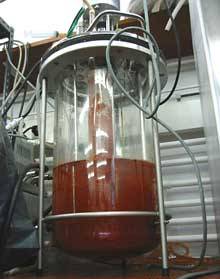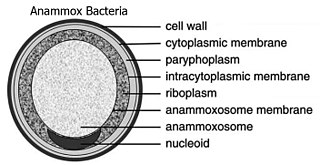
The family Enterobacteriaceae is a very large family of Gram-negative bacteria that has been studied and characterized for almost a hundred years. It was first proposed by Rahn in 1936 and now included over 50 genera and over 200 species. Its classification above the level of family is a subject of debate, but one classification has it in the order "Enterobacteriales" of the class Gammaproteobacteria in the phylum Proteobacteria.

Bacilli is a taxonomic class of bacteria that includes two orders, Bacillales and Lactobacillales, which contain several well-known pathogens such as Bacillus anthracis. Bacilli are almost exclusively gram-positive bacteria.

Acidobacteria is a phylum of bacteria. Its members are physiologically diverse and ubiquitous, especially in soils, but are under-represented in culture.

The Chlamydiae are bacterial phylum and class whose members are a group of obligate intracellular bacteria, whose members are remarkably diverse, ranging from pathogens of humans and animals to symbionts of ubiquitous protozoa. They are ovoid in shape and stain Gram-negative. Historically it was believed that all Chlamydiae species had a peptidoglycan-free cell wall, but recent work demonstrates a detectable presence of peptidoglycan, as well as other important proteins. Many species belonging to this order are susceptible to antimicrobial agents. All known Chlamydiae only grow by infecting eukaryotic host cells. They are as small as or smaller than many viruses. They are dependent on replication inside the host cells, thus some species are termed obligate intracellular pathogens and others are symbionts of ubiquitous protozoa. Most intracellular Chlamydiae are located in an inclusion body or vacuole. Outside cells, they survive only as an extracellular infectious form. Chlamydiae can grow only where their host cells grow, and develop according to a characteristic biphasic developmental cycle. Therefore, Chlamydiae cannot be propagated in bacterial culture media in the clinical laboratory. Chlamydiae are most successfully isolated while still inside their host cells. Chlamydiae is the most common bacterial STD in the United States and 2.86 million chlamydiae infections are reported annually.

Anammox, an abbreviation for anaerobic ammonium oxidation, is a globally important microbial process of the nitrogen cycle that takes place in many natural environments. The bacteria mediating this process were identified in 1999, and were a great surprise for the scientific community. "Anammox" is also the trademarked name for an anammox-based ammonium removal technology developed by the Delft University of Technology.

"Candidatus Brocadia anammoxidans" is a bacterial member of the order Planctomycetes and therefore lacks peptidoglycan in its cell wall, and has a compartmentalized cytoplasm.
The indole test is a biochemical test performed on bacterial species to determine the ability of the organism to convert tryptophan into indole. This division is performed by a chain of a number of different intracellular enzymes, a system generally referred to as "tryptophanase."

Betaproteobacteria are a class of gram-negative bacteria, and one of the eight classes of the phylum Proteobacteria.
Mycobacterium haemophilum is a species of the phylum Actinobacteria, belonging to the genus Mycobacterium.
The Chloroflexi or Chlorobacteria are a phylum of bacteria containing isolates with a diversity of phenotypes, including members that are aerobic thermophiles, which use oxygen and grow well in high temperatures; anoxygenic phototrophs, which use light for photosynthesis ; and anaerobic halorespirers, which uses halogenated organics as electron acceptors.
Nitrospirae is a phylum of bacteria. It contains only one class, Nitrospira, which itself contains one order (Nitrospirales) and one family (Nitrospiraceae). It includes multiple genera, such as Nitrospira, the largest. The first member of this phylum, Nitrospira marina, was discovered in 1985. The second member, Nitrospira moscoviensis, was discovered in 1995.
CandidatusScalindua wagneri is a Gram-negative coccoid-shaped bacterium that was first isolated from a wastewater treatment plant. This bacterium is an obligate anaerobic chemolithotroph that undergoes anaerobic ammonium oxidation (anammox). It can be used in the wastewater treatment industry in nitrogen reactors to remove nitrogenous wastes from wastewater without contributing to fixed nitrogen loss and greenhouse gas emission.
"CandidatusScalindua" is a bacterial genus, and a proposed member of the order Planctomycetes. These bacteria lack peptidoglycan in their cell wall and have a compartmentalized cytoplasm. They are ammonium oxidizing bacteria found in marine environments.

Candidatus Legionella jeonii is a candidatus bacterium from the genus Legionella. Previously known as X-bacterium, Candidatus Legionella jeonii grows symbiotically in Amoeba proteus. This endosymbiotic relationship was first noticed by Kwang Jeon in 1966.
"Candidatus Caballeronia nigropunctata" is a Candidatus species of bacteria from the genus Caballeronia and the family Burkholderiaceae. "Candidatus Caballeronia nigropunctata" is an endosymbiont of the plant Psychotria nigropunctata.
"Procabacteriaceae" is a Candidatus family of uncultivated Gram-negative Betaproteobacteria. The sole genus, "Procabacter", was identified as an obligate endosymbiont of Acanthamoeba.
Ammoniphilus is a Gram-variable, strictly aerobic, rod-shaped, haloalkalitolerant spore-forming, obligately oxalotrophic and motile bacterial genus from the family of Paenibacillaceae with peritrichous flagella. In the cell wall of Ammoniphilus is meso-diaminopimelic acid.
Caballeronia is a genus of bacteria from the family of Burkholderiaceae.







